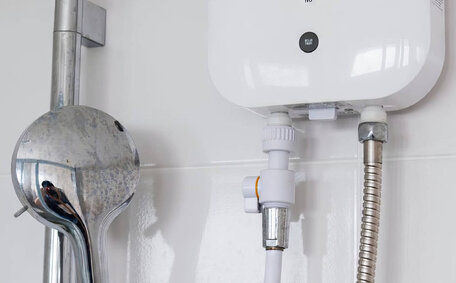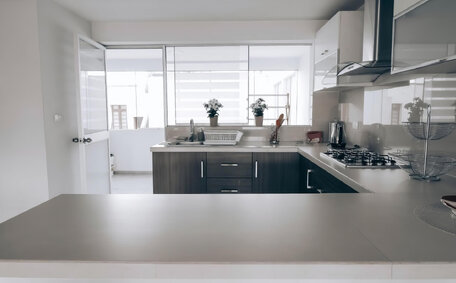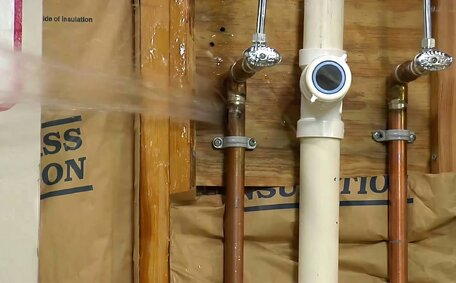Introduction: How Plumbing Layout Impacts Drainage
Plumbing systems aim to optimise water flow and drainage within your property. The size and slope of wastewater pipes, the positioning of fixtures, vents, and taps, along with the connection point to the main sewer line, all affect how efficiently water is removed from a property.
Poorly executed plumbing layouts can overburden wastewater systems. Ultimately, poor plumbing layout is a common cause of clogged drains. Venting issues also impact drainage, while cross-connections between fixtures can overload pipes.
Blockages can result when water flow is impeded by factors such as undersized pipes, inadequate slopes, excessive bends, and remote fixture locations.
At Bexley Plumbing, we use our trusted plumbing expertise with experienced professionals ready to assess your plumbing layout and identify improvements to optimise drainage and prevent blockages. Get in touch with our team to enhance the efficiency of your plumbing system.
Identifying Signs of a Blocked Drain
Multiple signs may indicate the presence of a blocked drain in your plumbing system:
Slow Draining Water
Sinks, tubs, or toilets draining slowly often indicate a partial or complete blockage, possibly requiring an electric eel or a drain snake, preventing wastewater from flowing freely through the pipes. Toilets with standing water that drain slowly are a definitive sign of blockage.
Gurgling Noises
Strange gurgling sounds coming from your drain can signal a partial blockage. As water attempts to drain through a narrowed pipe opening, debris can create bubbles and odd noises.
Unpleasant Odours
Blocked sewer drain pipes may give off foul sewage smells, especially from floor drains. The blockage causes wastewater to back up and release gases. A musty, rotten egg odour usually means there is organic matter causing a clogged drain.
Low Water Pressure
If the water pressure at your fixtures seems lower than normal, a drain blockage could be preventing proper venting. Clogs limit air intake, creating a vacuum effect that reduces pressure.
Overflowing Drains
Drains, regardless of the situation’s severity, can become overtaxed and overflow as wastewater fails to drain. Sinks may fill with standing water, while toilets may bubble up and overflow, calling for immediate attention before you face the issue the next time.
These issues often stem from improper plumbing layout, and a solution might include using a water jetter to improve wastewater drainage efficiency. Undersized pipes, insufficient slope, and remote fixture locations can all contribute to recurring clogs. Contact your local plumber at Bexley Plumbing to inspect your plumbing system and identify solutions to optimise drainage.
Common Causes of Blocked Drains
Homeowners should be aware of several common causes of blocked drains:
Tree Roots
Invasive root systems, seeking moisture, can infiltrate sewer lines and cause havoc inside your entire plumbing infrastructure. As roots spread underground seeking water, they can worm their way inside a sewer drain pipe through cracks and joints. The roots thrive in the moist environment inside sewer pipes, growing larger over time until they cause major blockages.
In suburbs like Bexley, Sydney, tree roots pose significant wastewater management challenges due to the clay-based soil and drought conditions. Homeowners can find their properties at higher risk of tree root invasions causing blockages.
Foreign Objects
Various foreign items such as wet wipes flushed down toilet or washed down your drains can cause obstructions. Some common culprits include diapers, baby wipes, feminine hygiene products, toilet paper, dental floss, food scraps, hair, grease, toys, and other items sent down your drains.
Poor plumbing layouts prone to backups increase the likelihood of blockages. Limited water flow allows objects increased opportunity to become lodged in pipes.
Mineral Build-Up
Hard water areas with high mineral content can affect your pipes by leading to gradual calcium, magnesium, and limescale accumulation along pipe walls, eventually causing a drain clog. Over time, mineral build-up narrows pipes, impeding storm water and reducing overall drainage.
Corrosion and rust flakes from ageing pipes also add to the debris mass, as do small bits of loose mortar from poorly installed joints.
Grease and Oil
Grease and oil from washing machines and sinks can adhere to pipe walls, accumulating over time. As layers build up, they restrict water flow and often attract other debris too.
Accumulations of hair soap scum can bind with greases, making drain-clogging clumps and blockages worse.
To prevent blockages, dispose of grease properly using the hot water system and clean drains with a baking soda and vinegar solution.
How Pipe Layout Can Contribute to Blockages
Insufficient Slope
Drainpipes need an adequate downward slope to allow gravity drainage and keep the likelihood of a drain blocked at bay. A blocked drain can result from inadequate slopes, which should range from 1/4 inch per foot for 1 1/2-inch pipes to 1/8 inch per foot for larger pipes. Flatter gradients slow the wastewater flow, allowing solids to settle and start pipe blockages.
Undersized Pipes
If pipe diameters are too narrow, blockage your drainage might occur due to restricted water flow. This allows debris to snag and accumulate. For example, a bathroom with only a 1 1/2-inch drainpipe is prone to clogs.
Excessive Bends
Having too many tight 90-degree bends or elbow joints forces wastewater to change direction frequently. This disrupts flow and creates debris traps. Long sweep bends are preferable to minimise turbulence.
Remote Fixture Locations
When plumbing fixtures are located far from the main sewer connection point, it increases the likelihood of obstructions in the extended drainage pipe run. Long horizontal pipe lengths should be avoided.
Improper Venting
Inadequate venting alters air pressure in the system, reducing water flow. Vents need to be properly positioned at high points to allow air intake and maintain steady drainage.
Having your plumbing system assessed by a professional via our experienced team can identify layout issues prone to blockages. Maximise your drainage efficiency by consulting via our experts at Bexley Plumbing.
Strategic Plumbing Layout to Minimize Blockages
Strategically planning and designing your plumbing system is crucial in preventing frustrating and damaging blockages. At Bexley Plumbing, I highly recommend incorporating several strategic layout techniques to optimise drainage and reduce clogging:
Adequate Pipe Slope
Sewer pipes should slope 1/4 inch per foot for 1 1/2-inch pipes, and 1/8 inch per foot for 4-inch or larger pipes. Proper downward inclination provides the gravity flow needed to keep wastewater moving.
Sufficient Pipe Diameter
Undersized pipes are prime areas for obstructions. For the main drain, a minimum 4-inch diameter is recommended to ensure proper flow. Branch pipes leading from fixtures should be wider than 1 1/2 inches.
Minimal Bends
Excessive tight bends and elbows in your plumbing pipe work disrupt water flow. Opt for long sweep bends with a radius of at least 1 1/2 times the drain pipe diameter.
Direct Routing
Position drainage pipes in the most direct path possible to the main sewer drain. Avoid remote fixture locations and unnecessary detours.
Proper Venting
Strategic vent placement maintains air balance in the system, enabling smooth water flow. Vents should be located at high points and main junctions.
Cleanouts
Installing cleanouts at intervals makes clearing blocked drains easier without causing damage. Position them at turns and low spots where debris collects.
Dual Plumbing
Separating greywater from blackwater minimises causes blocked drains present and allows for more targeted waste management. It also takes load off the main drainage system.
Trust Bexley Plumbing for streamlined plumbing and drainage systems that minimise blockages and ensure continuous water flow. We also recommend bacteria-based enzyme cleaners for ongoing prevention.
When to Call a Professional for Drain Issues
Blocked drains can rapidly become complex, hazardous situations necessitating professional expertise for safe resolution. Although basic DIY approaches can tackle simple clogs, complex blockage issues warrant consulting a licensed plumber:
Multiple Fixture Backups
Slow draining or recurrent clogging across multiple fixtures often signals a larger system-wide blockage. Attempting to clear multiple backups yourself risks making the situation worse.
Sewage Odours Indoors
Foul smells of sewage surfacing inside often signal that wastewater is backing up due to a major blocked sewer line clog or break. The hazards of raw sewage require immediate professional mitigation.
Gurgling Sounds from Drains
For persistent gurgling noises, it’s wise to rely on local emergency plumbing services to assess your blocked drains. Have a plumber inspect and clear them before complete clogging occurs. Improper actions during a plumbing situation can cause damage to your pipes, so getting professional advice is critical.
Overflowing Fixtures
Should your sinks or tub start overflowing with standing water, call our reliable team, as your drains are fully blocked. Allowing backups to spill over creates unsafe conditions for your home with harmful bacteria and viruses.
Slow Water Drainage Outside
Pooling water or poor drainage near your roof can indicate a collapsed sewer line or disruption in sewage service. Professionals have specialised equipment, including pipe relining tools, to locate and repair breaks without excavating your yard.
For timely solutions to keep your drains and sewer line operating safely and efficiently, contact our experts at Bexley Plumbing on 1300 349 338 or [email protected].
Routine Maintenance to Prevent Blocked Drains
Conduct regular drainage system maintenance to avoid recurrent blockages and costly plumbing repairs. Here are some simple, proactive steps homeowners can take:
Flush Weekly with Enzyme Cleaner
Use an enzyme-based foaming cleaner weekly to dissolve organic matter and maintain clear drains, especially following heavy rain. Products containing microbial cultures can help maintain safe conditions for pipes.
Pour Boiling Water Monthly
Monthly, pour boiling water with baking soda down drains to dissolve fat build-ups and clear obstructions of soap scum, hair, and debris.
Clean Sink Strainers and Traps
Regularly remove and clean sink strainers, pop-up stoppers, and p-traps to ensure your drains remain free of accumulated gunk, thus allowing water to flow unobstructed.
Inspect and Replace Pipes
Check exposed pipes for cracks or damage that can lead to catching debris and subsequently to clogs. Update old clay pipes and those made of iron or lead that are prone to blocking to avoid frequent clogs.
Trim Intrusive Roots
Inspect around your property for protruding roots from surrounding trees that can invade and break pipes. Trim them back carefully.
Professional Drain Cleaning
Annually, have a professional inspect and clear your drains with high-pressure water jetters and CCTV to maintain unobstructed pipes.
Adopting proactive drain maintenance practices is crucial for maintaining a hassle-free plumbing system. The team at Bexley Plumbing know how to advise on the best techniques for your home.
Conclusion
The strategic layout and design of plumbing systems are key to preventing drain blockages. Carefully considering pipe slopes, sizing, routing, and venting helps wastewater drain freely without debris accumulating. Though standard methods may remedy infrequent clogs, persistent or severe blockages typically point to deeper issues, such as blocked sewer lines, which require professional assistance.
In the Bexley area, tree root invasion stands as a leading cause of sewer line obstructions due to the area’s clay soil conditions.
Inadequately designed pipes are prone to accumulations of grease, foreign objects, and mineral deposits that result in blockages. Identifying drainage issues early and contacting a professional prevents minor clogs from becoming major headaches.
Routine maintenance, including enzyme treatments, strainer cleaning, and professional drain inspections, is essential to prevent systemic plumbing issues. Proactive homeowners can avoid the consequences of blocked drainage, destructive pipe damage and expensive repairs by staying vigilant.
To address and prevent blocked drains or persistent clogs, connect with Bexley Plumbing by reaching out to our team on 1300 349 338. Our licenced experts, who demonstrated the job was very thoroughly executed, have the advanced tools and expertise to inspect your entire drainage system and restore proper function. Secure your tranquillity and call us early to tackle drain problems before they escalate to overflowing fixtures and backed-up sewage. Call us today.






